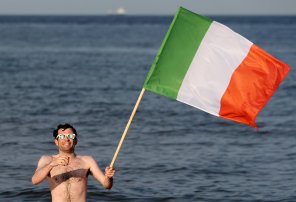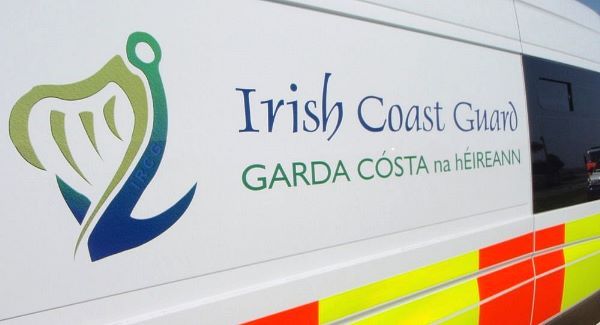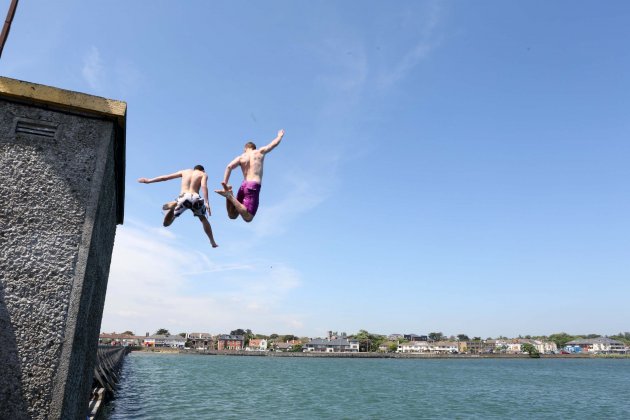Ireland Debt Outlook Raised at S&P on Impact of Budget Cuts


Standard & Poor’s raised its outlook on Ireland’s sovereign rating, saying the government may exceed its targets for debt reduction as the economy recovers.
The ratings company lifted the outlook on the nation’s BBB+ grade to positive from stable, it said in a statement today. There is a one-in-three chance the rating will be raised in the next two years.
 “Ireland could over-achieve its fiscal targets and reduce its government debt faster than we currently expect,” S&P said. “Ireland’s economic recovery is under way.”
“Ireland could over-achieve its fiscal targets and reduce its government debt faster than we currently expect,” S&P said. “Ireland’s economic recovery is under way.”
S&P also affirmed Germany’s AAA rating today with a stable outlook. That judgment and its view on Ireland contrasts with the company’s decision earlier this week to cut its rating on Italy’s debt to BBB from BBB+, with a negative outlook, because of that country’s continued recession.
Of the three major ratings companies, S&P now has the most positive outlook on Ireland. Fitch Ratings has the nation on BBB+ rating with a stable outlook, while Moody’s Investors Service has it at non-investment grade and a negative outlook. Investors often ignore ratings, evidenced by the rally in Treasuries after the U.S. lost its top grade at S&P in 2011.
While today’s S&P revision is “good news” for Ireland, Moody’s “stubbornness in holding on to its sub-investment grade rating remains an unhelpful overhang on the sovereign” and its banks, Philip O’Sullivan, an economist at Investec Plc (INVP) in Dublin, said in a note.
FISCAL PROGRAM
The Irish government is pressing on with budget savings after needing a bailout in 2010 and is also working on a plan to recoup some of the money it plowed into failing lenders from the euro area’s backstop fund. Ireland’s Finance Ministry said on its Twitter feed that S&P’s improved outlook highlights the success of the country’s fiscal-consolidation program.
The National Treasury Management Agency said the move acknowledges the country’s improved access to capital markets and fiscal situation. Ireland is aiming to be the first euro-area country to exit a bailout at the end of the year.
S&P said government debt will peak at 122 percent of gross domestic product this year and decline to 112 percent by 2016. It said the “strong consensus” among the country’s largest political parties for fiscal consolidation “supports Ireland’s policy and institutional effectiveness.”
OUTLOOK RISKS
While the economy is recovering, S&P said weak foreign demand means growth will remain slow this year and next and risks to the outlook remain. Banks still have “very high levels” of non-performing loans and the country’s access to external funding is “fragile.”
Economic data for the nation has been mixed in recent weeks. The Irish economy slipped back into recession in the first three months of the year to mark a third consecutive quarter of contraction. In contrast, tax revenues exceeded the government’s target by 1 percent in the first half, and the nation’s budget deficit declined.
The yield on 10-year Irish bonds was 3.9 percent today. While it’s up from a low of 3.41 percent in May, it reached a peak of 14.219 percent in 2011.
Yields on sovereign securities moved in the opposite direction from what ratings suggested in 53 percent of 32 upgrades, downgrades and changes in credit outlook last year, according to data compiled by Bloomberg published in December. Investors ignored 56 percent of Moody’s rating and outlook changes and 50 percent of those by Standard and Poor’s. That’s worse than the longer-term average of 47 percent, based on more than 300 changes since 1974.
On Germany, S&P said today that it predicts the economy will maintain “steady” growth in the medium term.
“The stable outlook on our long-term rating on Germany reflects our expectation that its public finances will continue to withstand potential financial and economic shocks and that consensus in favor of prudent economic policies will remain,” S&P said.
Irish Mental health service’s ‘failing our children miserably’
CHILDREN IN STATE CARE ARE BEING FURTHER TRAUMATISED BY THE MENTAL HEALTH SYSTEM ITSELF, A MAJOR REPORT HAS CLAIMED.
Professionals involved in the service have described it as “traumatised and traumatising” and have pointed to the absence of child-centred care with organisations “focused on their own outputs rather than the child’s needs”.
The Someone To Care report by the Children’s Mental Health Coalition has found substantial deficiencies, poor resource allocation and a focus on crisis management rather than early intervention.
Considerable dissatisfaction was expressed “at the dominance of the medical model in service structure and delivery”.
The report has also pointed to multiple placements and a lack of coordination between State agencies making it hard for children to develop trusting relationships.
It has called for service providers to listen to the voice of the child and involve young people in planning service developments.
FRAMEWORK
It wants a national strategy to address the mental health needs of children and young people in the care of the State and a common assessment framework and on-going monitoring of their needs.
The report has also called for stability for children in care and in youth justice systems with adequate equitable access to services and training programmes which identify and understand psychological well-being issues.
Orla Barry, Director of Mental Health Reform and incoming Chair of the Children’s Mental Health Coalition, said the report marked “what we hope will be the beginning of a process”.
“It identifies the imperative need for a joined-up system that really addresses the mental health needs of young people in care and in the youth justice system.”
She added that one of the strongest messages from the young people interviewed in the report was the need for stability and continuity in care, which was often missing from their lives.
“If they could develop a single trusting relationship, the impact would be enormous. This means we need the different agencies working with the young people to comprehensively and effectively work together.”
Galway man bit in face by a conger eel ‘lucky to be alive’
A GALWAY MAN SAYS THAT HE IS “EXTREMELY LUCKY TO BE ALIVE” AFTER A FREAK INCIDENT WHERE A GIANT CONGER EEL BIT AWAY A HUGE CHUNK OF HIS FACE.
Jimmy Griffin (48), who is an experienced deep sea diver for over 20 years, came into difficulties as he made his way back from an expedition in Killary Fjord, Connemara, Co Galway.
“Suddenly I got hit with what felt like a really strong punch in the face,” Mr Griffin told the IrishIndependent. “I felt like a rag doll. It gripped onto my face and threw me about violently. It was biting, pulling and twisting on my face,” he said.
“I knew I had been attacked but at this stage I didn’t know what happened. I got this horrendous feeling of numbness in the left side of my face,” said Griffin.
“My regulator fell out and my vision became really cloudy because of the blood rising in the water in front of me. The blood looked like octopus ink, very dark,” he added
Mr Griffin attended the dive in Killary Fjord, which was part of a sports gear manufacturer’s promotion to test out new equipment. Despite his experience, it had been over two years since he was last deep sea diving.
“I am a very lucky man to be alive today. I owe my life to so many people who made sure I got to the hospital,” said Griffin
“The plastic surgeons have done a fantastic job. I don’t even know how many stitches I have on both the inside and outside of mouth but they say the scar will eventually be unnoticeable,” he said.
Irish Coastguard issues water safety warning after five drownings during warm weather spell


THE IRISH COASTGUARD HAS ISSUED A FRESH SAFETY WARNING FOR THOSE TAKING TO THE WATER DURING THE CONTINUED HEATWAVE.
Among the advice is to wear a personal floatation device and never swim alone, or after drinking alcohol.
Five people have drowned in the past week, including a 19-year-old man in a Co Roscommon lake last night and a 10-year-old boy in Youghal in east Cork yesterday.
Johnm Leech, Chief Executive of Irish Water Safety, appealed to swimmers to take extreme care.
“Fresh water is more dangerous than salt water, that’s the first thing we’d say,” he explained.
We’d ask everyone to swim on lifeguarded waterways, and there’s a whole list of them with all the hours that lifeguards are on duty [online].”
“The lifeguards are professional, they’re very good at their jobs … they will keep your family safe.”
Cigarette’s and drinking speed up our cognitive decline ‘Scientist’s say’


It is already widely acknowledged that smoking and drinking too much are bad for our health. Now a new study has found that when done together, smoking and heavy drinking speed up cognitive decline.
According to UK scientists, these two habits often occur together, therefore they wanted to assess the combined effect of them on cognition – a group of mental processes that include memory, problem solving, decision making and language skills.
They monitored the progress of over 6,400 adults, aged between 45 and 69, over a 10-year-period. All of the participants provided information about their smoking and drinking habits and their cognitive abilities were tested throughout. This included tests on verbal fluency, memory and mathematical reasoning.
The scientists from University College London found that cognitive decline in current smokers who were also heavy drinkers was 36% faster compared to non-smokers who were moderate drinkers. Furthermore, among smokers, the more alcohol a person consumed, the faster the cognitive decline.
“Our research shows that cognitive decline was 36% faster in those people who reported both cigarette smoking and drinking alcohol above the recommended limits. When we looked at people who were heavy-drinking smokers, we found that for every 10 years that they aged, their brains aged the equivalent of 12 years,” explained lead researcher, Dr Gareth Hagger-Johnson.
The recommended weekly allowance of alcohol is no more than 21 units for men and 14 units for women. A unit of alcohol is considered a small glass of wine (100ml), a pub measure of spirits (35.5ml) or a glass of beer/cider/stout (284ml).
The scientists pointed out that from a public health perspective, ‘the increasing burden associated with cognitive aging could be reduced if lifestyle factors can be modified’.
“We believe that people should not drink alcohol more heavily in the belief that alcohol is a protective factor against cognitive decline. Current advice is that smokers should stop or cut down, and people should avoid heavy alcohol drinking.
“Our study suggests that people should also be advised not to combine these two unhealthy behaviours – particularly from mid-life onwards. Healthy behaviours in midlife may prevent cognitive decline into early old age,” they said.
Deep blue planet HD89733b discovery differs from our Earth


DATA FROM THE HUBBLE SPACE TELESCOPE HAS HELPED DETERMINE THAT A PLANET ORBITING A NEARBY STAR LIKELY SHARES EARTH’S DEEP-BLUE TONES, BUT THE SIMILARITIES STOP THERE, ASTRONOMERS REPORT.
The planet, HD 189733b, circles a star some 63 light years away, about 372 trillion miles, according to the upcoming Astrophysical Journal Letters report led by the University of Oxford’s Tom Evans. The Jupiter-size planet, about 13% heftier than the largest planet in our solar system, orbits very close to its star, circling it once every 2.2 days. That makes it a (very) ”hot Jupiter” planet, the study notes, with cloud temperatures likely around 1,800 degrees Fahrenheit and winds whipping around at 4,350 miles-per-hour.
Astronomers have detected more than 800 “exoplanets” — planets that orbit stars outside our solar system — in the last two decades. HD 189733b was discovered in 2005.
The planet’s clouds are likely blue, based on spectroscope data from Hubble, according to the international team of astronomers. The space telescope peered at the planet, before, during and after it was eclipsed by its star. That enabled the astronomers to subtract the light from the star from the light reflected off the planet, giving them a sense of its color.
“We saw the brightness of the whole system drop in the blue part of the spectrum when the planet passed behind its star,” Evans says, in a statement. “From this, we can gather that the planet is blue, because the signal remained constant.”
The team suggests the blue color likely comes from a hazy atmosphere filled with melting glass particles, ones that scatter blue light.
“It is by no means a giant step forward, but a nice observation with implications for clouds in this hot Jupiter’s atmosphere, one of the key details for those who model the atmospheres of these hot planets,” says planetary theorist Alan Boss of the Carnegie Institution of Washington (D.C.). “It is amazing to think that we can now make measurements that tell us something about the cloud cover on distant exoplanets, and is especially amazing when we cannot even see these hot Jupiters directly.”




No comments:
Post a Comment